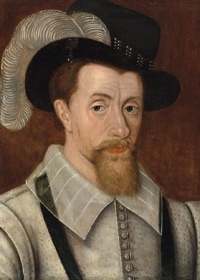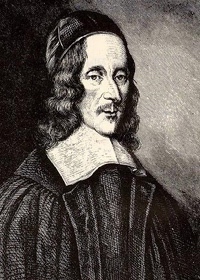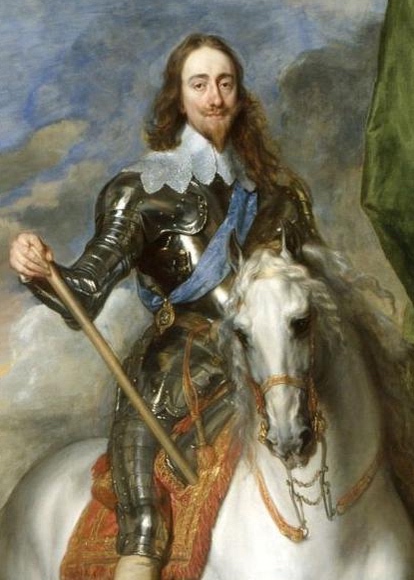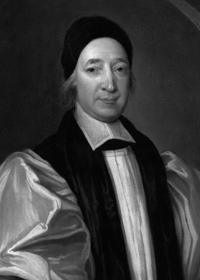
James I and the new English Bible Elizabeth I died in 1603. Since she had no children of her own, her heir was her cousin’s son, James VI of Scotland. James was a descendant of Henry VII and had been King of the Scots since infancy, when a group of Protestant lords forced his Roman Catholic mother to abdicate in his favor. With this new, Scottish dynasty, coming to the throne, the Puritan faction within the English Church hoped effect significant change in the form of worship. James, having agreed to hear their proposals, called a conference at Hampton Court to allow both Puritans and Churchmen to make their case.
The Churchmen were represented by Archbishop John Whitgift, and their goal was to ensure that nothing was done to violate the historic ministry or formularies of the English Church. The Puritans, led by John Reynolds, sought to reform the Church along more Presbyterian lines. While Reynolds and his colleagues may have thought that their Calvinist doctrine would find favor with a sovereign raised in the Scottish kirk, James had chafed at restrictions placed on him by Presbyterians advisors during his minority. When Reynolds made mention of a 「presbytery」 for England, the King expressed his displeasure, stating, 「no bishop, no king,」 and promising to 「harry out of the land」 those who disagreed with his position. The end result was that the Church retained its threefold ministry and Book of Common Prayer.
The Puritans did succeed, however, in emphasizing how important it was for the people to have a new translation of the Bible. Though the Scripture had been widely available in English since the 1540s, various parties had objections to the translations and glosses in both the Great Bible of 1539, and the Bishop’s Bible of 1568. It was therefore agreed that a new revision should be authorized, and a committee of forty-seven scholars were appointed for the undertaking. These men were among the most learned of their time, and over the course of seven years they produced what has ever since been called the King James (Authorized) Version of the Bible. Printed in 1611 and billed as being 「translated out of the original tongues, and with the former translations diligently compared and revised,」 it was a masterpiece, both of Biblical scholarship and of English prose.

The first half of the seventeenth century was also a high point for English poetry, particularly that of a religious nature. John Donne, George Herbert, Richard Crashaw, Robert Herrick, Henry Vaughn, and even Ben Jonson were producing exceptional devotional verse. Herbert’s poem on the British Church (1633) begins by comparing the extravagance of Papal Rome and and the plainness of Calvin’s Geneva to his Mother Church:
Outlandish looks may not compare; For all they either painted are, Or else undrest.
Though they have their allure, he concludes that the Church of England does best by taking the middle way,
But, dearest Mother, (what those misse) The mean thy praise and glorie is, And long may be.
Herbert’s imagery struck a chord with his fellow Churchmen, and his idea of Anglicanism as a via media between Geneva and Rome would long resonate within the English Church.
The Puritan Ascendancy James I died in 1625 and his son, Charles acceded to the throne. Charles I, was a pious and moral man, but his belief that the king should be a benevolent autocrat did not sit well with many of his subjects. After constant quarrels with Parliament over a period of many years, he sent its members home and for over a decade ruled without its help. In 1639, a crisis in Scotland, precipitated largely by an attempt to introduce the Book of Common Prayer, led to outright war between Scottish supporters of the king and his bishops, and those who favored the Presbyterian kirk. After a humiliating defeat, the King was forced to seek terms, and finding himself in severe financial straits, had no choice but to summon Parliament in an effort to raise taxes and replenish the treasury. The newly elected Parliament, however, had other ideas.

For many years, Puritans, who felt the Church of England was still too close to Rome, had been attempting to effect change from within. Where Puritan ministers were in charge, they considered it their right to depart from the established forms of worship. Their disregard for the Prayer Book and its prescribed form of worship was vigorously opposed by the Archbishop of Canterbury, William Laud. Where the Puritans had removed altars, he had them put back in place; parishioners were asked to kneel for prayers and for the reception of the Blessed Sacrament, which the Puritans disliked to do; and priests were ordered to restore the service according to the Book of Common Prayer, which the Puritans did not think was binding upon them.
Laud’s actions, which were admittedly heavy handed, earned him many enemies, and the Parlaiment of 1640 contained more than a few. The Archbishop was soon been accused of treason and imprisoned in the Tower. Not long after, the Earl of Strafford, a political ally of Laud and close advisor to the King, was imprisoned and executed on a similar charge. In 1642, Parliament siezed control of London, and Charles, fearing for the safety of his family and his own life, abandoned the city for the north, where royal support was strong. At Nottingham he raised his standard and assembled an army to defend the rights and privileges of Church and Crown. For the next six years the tide of battle flowed back and forth, but eventually, under the command of the staunch Puritan, Oliver Cromwell, Parliamentary forces won out. In 1649 the King was executed, the monarchy was abolished, and the Church was forced underground.
For the next ten years Cromwell ruled England as 「Lord Protector of the Commonwealth,」 and the Puritan party attempted to impose their own vision of what a godly state should look like. They did away with the episcopacy and put many thousands of clergymen out of their parishes. They did away with the Book of Common prayer and instituted services focused upon long sermons and extemporaneous devotions. Marriages In churches were prohibited, and the dead were often buried without religious ceremony. Church buildings were desecrated, as altars, organs, baptismal fonts, paintings, stained glass windows, and statues were all destroyed. When the Lord Protector died in 1658, he was succeeded by his son, Richard, but by that time, most of the English people had had quite enough Puritanism and republicanism and longed for a change. In 1660 a new royalist Parliament invited the sons of Charles I to return to England, where the eldest assumed the throne as Charles II.
Restoration of Church and Crown While the Puritans were in power, eighteen bishops died in prison or in exile. At the Restoration, the eight bishops who had survived the Commonwealth era were returned to their sees. Those among the lower clergy, whom the Puritans had ejected, were restored to their parishes, but many Puritan ministers were allowed to remain, so long as they received priestly ordination and agreed to use faithfully the Book of Common Prayer. Those who did not were allowed to withdraw into nonconformist bodies of their own.
Charles II died in 1685 without issue, and with the succession came another crisis. His brother and heir, James Stuart, had lived a number of years in France and Spain, and in that time had become an avowed adherent of the Roman Catholic Church. He came to the throne with the definite aim of restoring the Roman Church in England and did all that he could to achieve that end. It was not long, however, before the people of the nation were aroused to resentment by this policy and began to show their antagonism more and more openly. After only three years James II was forced to the country to escape the wrath of his subjects. In 1688, seven peers of the realm, including the Bishop of London, invited James’s son-in-law, William, Prince of Orange, and his wife Mary, to become King and Queen of England. With little support among the people, James fled to France, where he remined in exile until his death in 1701.

The Non-Jurors Because James II did not abdicate, there were a number of bishops who still felt bound by their oaths of allegiance, and therefore could not in good conscience accept William as King. Though they did not actively oppose the new regime, because they did could take the necessary oaths of allegiance, they came to be called nonjurors, from the Latin non juro (I do not swear). This was unacceptable to the crown, and the nonjurors were eventually deposed from their sees. All in all, nine bishops, including William Sancroft, the Archbishop of Canterbury, refused to take the oath. Because most of these were of the High Church party, the balance of power shifted to into latitudinarian hands. Unfortunately their broad understanding of 「things indifferent」 would lead to an era of religious indifference in general in the years ahead.
One of the more famous nonjurors was Bishop Thomas Ken of Bath and Wells. After being deprived of his see, Ken retired to the manor of Longleat, where he continued his earlier hobby of writing hymns, one of which is the Doxology used in many Anglican churches today–Praise God from whom all blessings flow. Ken’s deathbed pronouncement expresses well the sentiment of many High Church Anglicans of the time. He wrote, 「I am dying in the Holy, Catholic and Apostolic Faith professed by the whole Church before the disunion of East and West; and, more particularly, in the Communion of the Church of England, as it stands distinguished from both Papal and Protestant innovation, and adheres to the Doctrine of the Cross.」
Another well known nonjuror was the theologian, William Law. Posessing a keen intellect and generous spirit, he had a wide variety of friends, including Edward Gibbon and Samuel Johnson. He argued strenuously against the Bishop of Bangor, who in 1717 suggested that because Christ’s kingdom is not of this world (John 18:36) there is no biblical justification for church governance. Thus what currently existed in England was merely a system that was instituted of men. Though such opinions may have been in vogue among the latitudinarians, they were far removed from the traditional understanding of the English Church and the catholic faith. But it may have been Law’s other writings that proved more effective in reversing the latitudinarian trend. Works like Christian Perfection and A Serious Call to a Devout and Holy Life influenced the thinking of major figures of the eighteenth century evangelical revival, including John Wesley and George Whitfield.